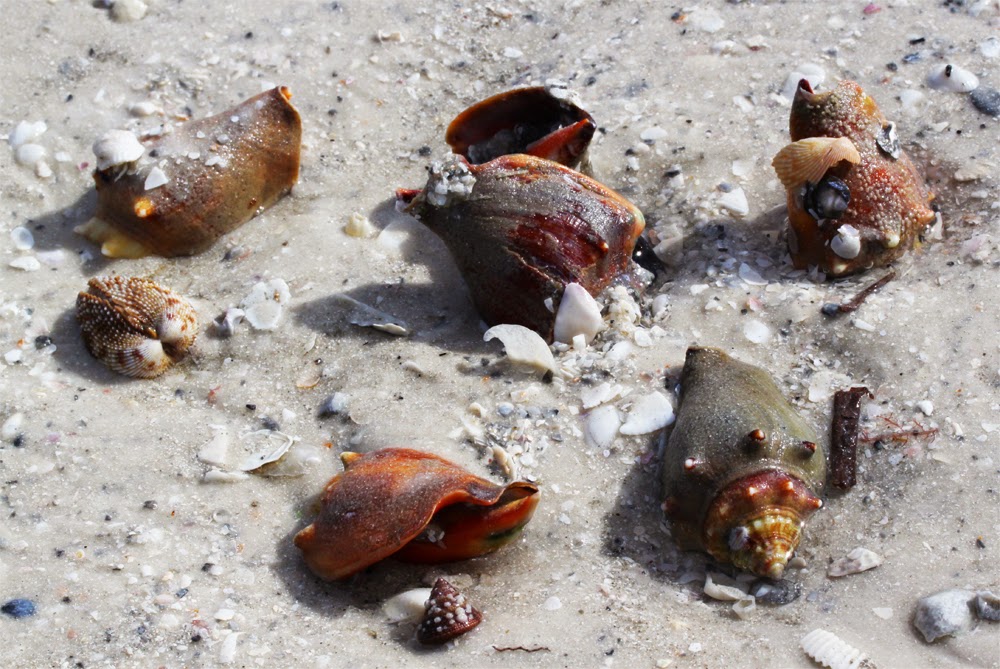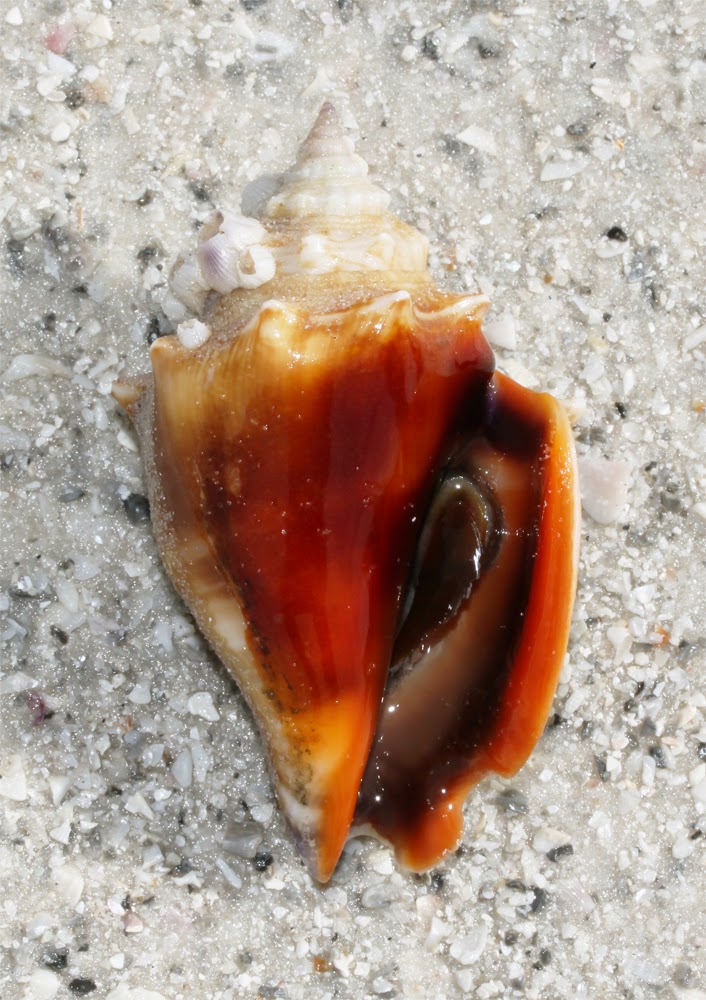In early January of this year (2015), I was finally able to make a
trip I've been thinking of since childhood - a trip to the beaches of Florida
for shelling. We focused on the Gulf Coast, choosing a motel that served as home
base in Englewood, Florida (which is a little bit north of Fort Myers).
Florida has a lot of excellent State Parks and other
well-maintained natural areas along the Gulf Coast. No live shelling is allowed
in the state parks, and other localities restrict live shelling as well, such
as Sanibel Island. If one arrives before low tide, one has a chance to still
find many nice specimens of empty shells in these localities. The competition
is pretty fierce, though, and the beaches quickly fill up with eager bag-toting
shellers!
Day One: We explored a bit in the Englewood area in the
afternoon (after a red-eye flight from San Diego the night before!). Manasota
Key has nice gulf-facing beaches, but also has public access to Lemon Bay,
which is sandwiched between the key and the mainland. One can explore the
shallow water near the mangroves on the bay side, and many interesting mollusks
can be found here. The light was failing when we explored the bay side on this
day, but immature Florida crown conchs were "hanging out" on the
muddy beach and in the shallow water. One appeared to be feeding on a mysterious
object that might have been an old octopus's arm.
 |
| Melongena corona, an immature Florida Crown Conch. Manasota Key, Florida. |
 |
| Melongena corona, Florida Crown Conch, feeding. Manasota Key, Florida. |
Lightning whelks were common on the bay side as well, some
feeding on the numerous oysters that are thick at the base of the mangroves.
 |
| Busycon sinistrum, Lightning Whelk, eating an oyster among the mangroves. Manasota Key, Florida. |
Day Two: This was our Sanibel Island day, but we unwisely
got a slightly late start in the morning and arrived at Lighthouse Beach on
Sanibel about 10 minutes past the peak low tide (which was around 8:30 am). At
that point the hoards of shellers who got there earlier had scooped up most of
the easy-to-find empty shells. There were many live mollusks on the sand bars
exposed by low tide, though, so I focused on photography of them, as opposed to
collecting.
 |
| Bulla striata, live Atlantic Bubbles. Lighthouse Beach, Sanibel Island, Florida. |
 |
| An immature Florida Fighting Conch. There were lots of immature ones on this beach, but we never saw adults ones here at all. |
 |
| Oliva sayana, Lettered Olive. This one is burrowing in the sand at low tide. Lighthouse Beach, Sanibel Island, Florida. |
 |
| Live Lettered Olives, Lighthouse Beach, Sanibel Island., Florida. |
 |
| Live Nassarius vibex, Bruised Nassa. A little guy - crawling on the sand as the tide came in. Lighthouse Beach, Sanibel Island, Florida. |
 |
| A colorful live Ficus ficus, Paper Fig Shell. On a sand bar, Lighthouse Beach, Sanibel Island, Florida. |
 |
| Terebra dislocata, Eastern Auger. There were many immature ones burrowing in the sand at Lighthouse Beach. |
Before leaving Sanibel, we paid a visit to Gulfside Park and
its adjacent beach. I brought snorkeling equipment and decided to give it a
shot at this beach, but the water was so turbid that visibility was essentially
zero. The beach itself was littered with Rigid Pen Shells, most in fairly poor
condition. Sea whips had washed up, but none with simnias attached. Ponderous
arks were scattered along the wrack line, also, which are extremely common in
Florida, but I was happy to scoop up some with both valves intact and the mossy
periostracum present.
We left Sanibel in the early afternoon, as I wanted to
explore Manasota Key in the daylight more. We had several hours to do just
that, and found a large banded tulip, more lightning whelks and Florida crown
conchs on the bay side.
 |
| Cinctura hunteri, Banded Tulip, Manasota Key, Florida. |
 |
| Busycon sinistrum, Lightning Whelk. A younger individual, with more distinct markings. Manasota Key, Florida. |
 |
| An older Lightning Whelk, from Manasota Key, as well. |
Day Three:
On this day we planned to drive around two hours south of
Englewood to Marco Island, and then explore the Big Cypress National Preserve
(with birding, not shelling in mind!).
This time we wisely arrived at Tigertail Beach on Marco
Island around an hour before low tide. A cold weather system had moved into
Florida, and it was in the low fifties (and windy) when we arrived at the
public beach parking area. This is not a huge parking lot so arriving early is
wise for many reasons. We had carefully looked at satellite images of this area
in advance, and also had heard that one could wade across a shallow lagoon to
get fast access to the gulf-side beach. That lagoon was not so shallow and
after my husband Gary quickly was up to his thighs, with what looked like
deeper water ahead, we decided to take the alternate route to the beach, by
hiking south and around the lagoon, then hitting the beach on the southern end.
I'm glad we did, as the beach, and especially the sandbars, exposed by low
tide, were very rich in empty shells. By the way, although this is not a state
park, there are signs all over stating "No Live Shelling" at
Tigertail Beach, so be forewarned. The empty shells were excellent, though, and
my best shelling of the trip happened here, as we hiked north towards the
northwest corner of the island.
 |
| Scaphella junonia, a slightly worn specimen, in a little tidal "pond". Tigertail Beach, Marco Island, Florida. |
 |
| Dinocardium robustum, Atlantic Giant Cockle. This species can reach 5 inches in length, and there were many of this size on Tigertail Beach. This was burrowing in the sand (a popular activity for mollusks on the beach!). |
 |
| A "colony" of Florida Fighting Conchs, Marco Island, Florida. There were many groups like this, revealed by low tide, with easily a dozen or more live conchs per group. |
 |
| A nice mature, live Strombus alatus, Florida Fighting Conch. Tigertail Beach, Marco Island, Florida. |
 |
| A good-sized, empty Sunray Venus from Marco Island. |
 |
| Triplofusus giganteus, Florida Horse Conch. This is a shell that shellers always hope to find, so I feel VERY lucky to have spotted this big 10.5 inch long one on a sandbar at low tide, before the crowds descended. Tigertail Beach, Marco Island, Florida. |
Day Four:
My brother lives in Pinellas Park near St. Petersburg, so we
decided to make the most of the shelling in that area, since we wouldn't meet
up with him until 5 pm.
My brother Malcolm, who has lived in the Tampa bay area for
many, many years, recommended Fort De Soto State Park for birding (which was
another goal of the trip) and Honeymoon Island for shelling. In the end, after
spending about an hour early in the morning at Pass-a-Grille Beach with its
small breakwater (which had captured some nice shells, including an empty but
intact Dinocardium robustum with both
valves) we spent the entire morning and early afternoon at Fort De Soto SP, as
it was good for shelling and birding. Honeymoon Island (which is also a state
park) will have to wait for the next trip! The shelling along the wrack line
seemed to get richer and richer as we hiked north long the north-south
gulf-facing portion of the park. We met another (local) sheller who confirmed
that this pattern is not random, but that many intact shells tend to get caught
on that northernmost point. Once we rounded the northern tip and entered the
bayside, the shells tapered off, but the bay side had nice empty shells of its
own.
 |
| Haminoea antillarum, Antilles Glass Bubble. These delicate little things were in the muddy wrack line on the bay side at Fort De Soto State Park. They were empty (except for mud). They cleaned up nicely! |
Day Five:
This had to be a fairly short day as we would be getting up
well before dawn the next day to fly back to San Diego. So we explored Stump
Pass State Park, which is at the south end of Manasota Key (close to our motel).
The beaches yielded similar empty shells to what we had seen elsewhere
previously, but the richness of shells increased as we walked south to the
small channel at the south end of Manasota Key. Right at the channel, where
water was rushing out towards the gulf, some pelicans were fishing just a couple
feet from the shore, and then we saw a shark join the pelicans in the fishing
there! This drove home the reality that snorkeling in the Gulf should be done
with caution, and an understanding of the creatures you are swimming with! This
particular day seemed to be the coldest one yet, and we were bundled in
multiple layers, so I was not even considering getting in the water, but still
- the shark was an interesting wake-up call!
 |
| Donax variabilis, the "Coquina", a super-variably-colored (so aptly named) little bivalve. This yellow one was at Stump Pass State Park, Florida. |
 |
| Shelling in the chilly weather on the last day, Stump Pass State Park, Florida. |
If I had to do this trip
over some time, I think I would try to plan a slightly longer stay. Five days (or
more accurately, four-and-a-half), especially with traveling as widely as we
did, did not make for the most relaxing experience! Something else that was
driven home by this trip, is that it's critical to arrive at beaches early in
the day, and before low tide, especially at well-visited beaches. I'm glad that
we decided to visit a variety of places, though, as originally I had planned to
stay at Sanibel Island almost exclusively. I also did not leave enough room in
my luggage for shells. I could have mailed some of the shells home, but decided
instead to mail my snorkeling gear (which got almost no use) instead. This
opened up room in my bags for my carefully-wrapped shells (with temporary data
labels), which took up even more space than I thought they would! I ended up
buying Ziploc bags, paper towels for padding and some inexpensive plastic food
storage containers for the shells for the return trip. Englewood has grocery
stores that are very convenient for such purchases.
Now the fun of cleaning, organizing, properly labeling and
storing my finds from this trip begins!





















